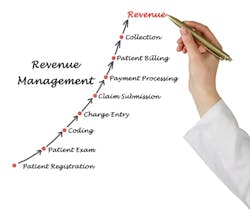Health System Execs Estimate Considerable Shifts in Payer Mix, Revenue Cycle IT Budgets Post-COVID-19
Approximately 70 percent of hospital and health system leaders are preparing for an increase in post-COVID-19 self-pay consumers and Medicaid beneficiaries, and a decrease in commercial reimbursement, according to a recent analysis.
The analysis, from consulting service company Guidehouse Center for Health Insights, is based on an executive survey conducted by Healthcare Financial Management Association (HFMA). For the study, researchers took an in-depth look at hospital and health system leader strategies over the next 12 months. The survey included 151 provider chief financial officers, and financial and revenue cycle executives, asking them about their projections in key areas such as payer mix shifts, consumer and employee experience strategies, revenue cycle IT budgets, electronic health record (EHR) satisfaction, and price transparency preparedness.
Notably, 92 percent of surveyed executives have increased telehealth use, with 73 percent using it to better-engage patients and address consumer responsibility. Executives also cited financial counseling and payment plans (63 percent), as well as online portals for price estimates and payment (56 percent), as strategies to better-engage consumers.
Guidehouse found that providers are planning for marked revenue cycle IT budget decreases. Over the next 12 months, compared with 2019 survey results:
· 35 percent of executives cited their organization’s IT budgets will increase, down from 69 percent.
· 27 percent of executives cited IT budget decreases, up from 5 percent.
“With health system margins primarily driven by elective services, the pandemic is gravely impacting provider revenue streams and payer mix,” said Timothy E. Kinney, Guidehouse partner. “As our economy labors post-pandemic, insured patients will struggle to shoulder greater cost sharing through high-deductible plans coupled with volatile unemployment rates. Healthcare leaders need to closely evaluate their payer mix and develop winning consumer experience strategies to overcome a slow recovery in patient volumes and an uptick in self-pay and Medicaid enrollees.”
Collaboration with external entities, including vendor partnerships (37 percent) and outsourcing (32 percent), were the most often cited strategies for decreasing revenue cycle costs and increasing economies of scale, according to the survey. In addition, 27 percent of executives cited using advanced health IT, including robotic process automation.
For the revenue cycle management workforce, almost 90 percent of providers have shifted to remote arrangements. Of those, nearly half have decided to continue with remote options and are reassessing future space-use needs. Moreover, only 12 percent of executives expect staff to return to pre-pandemic arrangements.
“As the revenue cycle workforce goes remote and budgets tighten, health system leaders are evaluating strategic investments in vendor partnerships and outsourced services,” said Mary Beth Briscoe, a senior advisor to Guidehouse who formerly served as a health system CFO and HFMA national board chair. “While digital technologies will be a necessity post-COVID-19, they must be methodically selected to ensure they are unlocking long-term performance improvement opportunities.”
What’s more, as EHRs continue to mature, providers appear to be benefiting from their capabilities. However, only one-in-five executives cited a seamless transition with their EHR to using telehealth, which has been an essential component to engaging with patients during COVID-19. Among respondents, compared to 2019 survey results:
· 42 percent cited EHR adoption benefits are outweighing challenges, up from 31 percent.
· 68 percent cited they appropriately utilize available EHR functions, up from 59 percent.
· 55 percent cited they quickly adapted to functional releases, up from 44 percent.
Another key finding was that although the Centers for Medicare & Medicaid Services (CMS) hospital price transparency rule is scheduled to go into effect on Jan. 1, 2021, only 12 percent of executives said their organizations are ready to comply, with one-third suggesting they are unprepared. Concerns about disclosing rates to payers, media, and consumers (38 percent), and lack of an analytics infrastructure (26 percent), are cited as the biggest obstacles for compliance.


